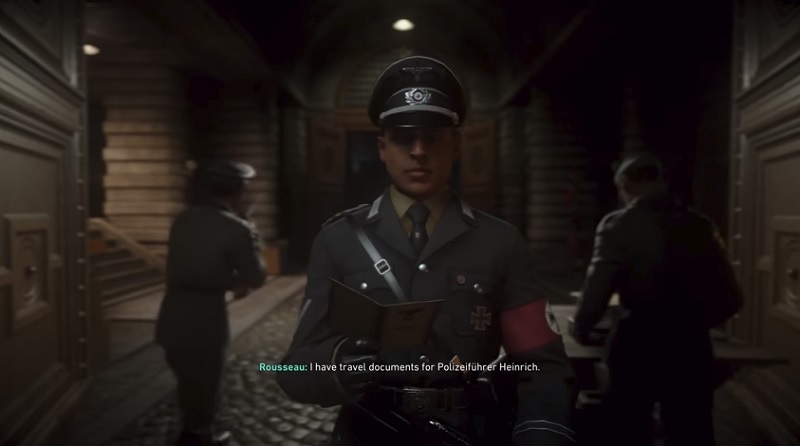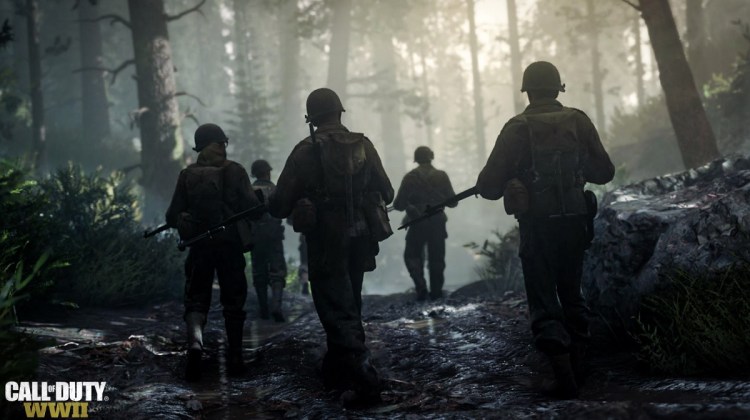Michael Condrey, studio head and cofounder of Sledgehammer Games, has just completed a three-year march to take Call of Duty back to the Second World War. Condrey and his co-studio head Glen Schofield led a team of 300 developers at Sledgehammer and another 200 elsewhere at Activision to complete Call of Duty: WWII, the reboot of the first-person shooter series that returns the game to infantry combat.
Getting the reboot right is important. The franchise has sold more than 250 million units and $15 billion in sales since 2003. On average, that is more than 17 million units and $1 billion worth sold per year. Selling any less than that in a given year is considered a failure, according to Michael Pachter, an analyst at Wedbush Securities. Call of Duty: Infinite Warfare and Call of Duty: Ghosts were weak performers. At the high end of the spectrum was Call of Duty: Black Ops III, which sold 26 million units, and Sledgehammer’s own previous title, Call of Duty: Advanced Warfare, sold 22 million units, Pachter said.
(Here’s our other coverage of Call of Duty: WWII).
That gives you an idea of the kind of pressure Sledgehammer is under. The team immersed themselves in history, and their game, Call of Duty: WWII, debuts today on the Xbox One, PlayStation 4, and PC. The title has a single-player campaign that tracks a squad from the Fighting First, the 1st Infantry Division that saw so much action from D-Day on Omaha Beach to the crossing of the Rhine. Sledgehammer puts the player into the thick of the action in a return to “boots-on-the-ground” infantry combat.
June 5th: The AI Audit in NYC
Join us next week in NYC to engage with top executive leaders, delving into strategies for auditing AI models to ensure fairness, optimal performance, and ethical compliance across diverse organizations. Secure your attendance for this exclusive invite-only event.
Gone are the flying jumps from the sci-fi versions of the game. Now the game focuses on the story of a squad of soldiers fighting against the odds in a campaign that spans the full horror of the war. The game also has huge multiplayer and Zombies modes, as well as a new Headquarters social hub. I played all parts of the game at a review event and interviewed Condrey about what it took to get the job done.
Here’s an edited transcript of our interview.
Editor’s note: This story has narrative spoilers.

Above: Michael Condrey, studio head and cofounder of Sledgehammer Games.
GamesBeat: I’m looking at the Call of Duty poster. Is that a picture of you after three years of development?
Michael Condrey: (Laughs). They say that war brings out the best and the worst in people. I’m sure at some point in development it brought out both in me.
It’s interesting, though. When we started the campaign, we found these images of these young soldiers who went to war, and for soldiers who landed on Normandy in June of 1944, they were in combat something like — I can get the actual stats for you, but our military advisor was saying they only saw combat maybe three days out of a month. But they were still in the field in these harsh conditions. After 18 months overseas they’d come back looking like they’d aged a decade. This image was meant to capture that stare of a kid who’s gone to war and seen some rough things.
But for us it’s been a great three years. We put a lot into this one. We’re ready to share it with the world, that’s for sure.
GamesBeat: He’s looking at the squad as well. The story of the squad was an interesting one. It seems like you had a chance to develop a lot of characters and tie them together.
Condrey: It’s a more personal story, absolutely. The last episode of Band of Brothers, after you’ve watched Captain Winters and his crew, you get to meet the real Captain Winters, documentary style. He’s sitting on a couch being interviewed, and at one point he tells a story. He says, “My granddaughter asked me what it was like to be a hero in World War II.” This 70-year-old version of Captain Winters starts to cry and says, “I told my granddaughter I wasn’t a hero, but I served in the company of heroes.”
This man, by all accounts, was a hero. And yet 50 years after the war he doesn’t see himself as a hero. He considers the people around him, the camaraderie, the squad. It’s a sentiment I find very powerful. Our story was really about that. It wasn’t about the individual, a single protagonist played by a recognizable actor. It was about the camaraderie of men under extraordinarily harsh circumstances and what they did together. The squad becomes the center of it.
GamesBeat: Is that why you went with relatively unknown actors, then?
Condrey: We looked for performances first. We needed and wanted actors who could deliver these emotions. Josh Duhamel is known, and he did a phenomenal job with his character, but—this was not meant to highlight an individual soldier’s journey. All those arcs are powerful and important.

Above: Private Robert Zussman in Call of Duty: WWII.
GamesBeat: The campaign features about a dozen battles. I’m curious how you chose some of the characteristics of the scenes you focused on. It seems like a lot of them were the worst things that could possibly happen to an infantryman.
Condrey: First, we wanted to tell a story that was based on true events. We wanted to find a journey that emotionally resonated in the European theater. The First Infantry gave us that. Our squad is an original story within that. The First Infantry was 15,000 troops, so under that Big Red One umbrella, this is an original sort of tale.
Call of Duty is known for some big events, some impactful moments. I think when we first started researching the game, especially coming off Advanced Warfare, where we had the opportunity to do some pretty incredible set pieces — we began by looking at where we could deliver that level of action in a Call of Duty style that was authentically representative of the conflict. Thankfully, we found plenty of opportunities.
D-Day is iconic. It really anchors the Allied invasion. Cobra, which was a huge battle. The liberation of Paris. The destruction of Aachen. This really happened. We found these big set pieces that were based on what really happened in the war. But then we also wanted to juxtapose that against these choir moments, more tense moments, more personal moments. The big moments came about naturally through the massive conflict of the war.
Working with our military advisor, Marty Morgan, as we started to craft the narrative, it was easy. We would go to him and say, “We’re trying to get the First Infantry from here to here. We’d like to introduce the French Resistance. We’d like to show an ensemble cast. We’d like to show more than just an American story. What could we do for that?” “Oh, I’ve got the perfect idea. This happened here.” He was great about helping us take the creative arc we were trying to do in the story and then marrying that to what happened in the war.
Beyond that, he took us to these places. We talked about this before. We got to go to Aachen and feel the weight of that battle. It’s been quite a journey. Hopefully you felt that, some highs and lows. Big moments like Normandy, and some dark, personal moments. Zussman’s story, his rescue, those are — hopefully you felt that, some real emotion along that journey. They work well together.

Above: The French Resistance mission requires stealth.
GamesBeat: Zussman’s story seems to remind people of why the Allies are fighting the war. It shows this prejudice against Jews at the beginning of the conflict that wouldn’t necessarily come into a combat story.
Condrey: World War II, in some ways, is a bit faded from consciousness now. It’s been almost 80 years. Hitler’s genocide didn’t start with Jews. It started with his own people. It started with cripples and the elderly, in his own country, and then it spread. By the time it was over the genocide was atrocious, and there were a lot of countries and a lot of individuals complicit in that. So yeah, do you tell the story that it will never happen again? Absolutely. You tell the story because those who fought so it wouldn’t happen again can’t tell it for themselves.
GamesBeat: There’s this subtext of prejudice on the American side as well, and within the unit itself.
Condrey: That’s absolutely true. We wrestled with that quite a bit throughout development, trying to figure out the right balance of showing what was happening in the war, with the Nazis and their iconography and the language around what was happening with the genocide, without glorifying it. Knowing that this destruction and death happened, we couldn’t shy away from it.
At the same time we have to recognize what was happening in our own country in the ‘40s, right? Racism was rampant. Segregation was part of the war. We couldn’t be authentic to these challenges if we looked away from that as well.

